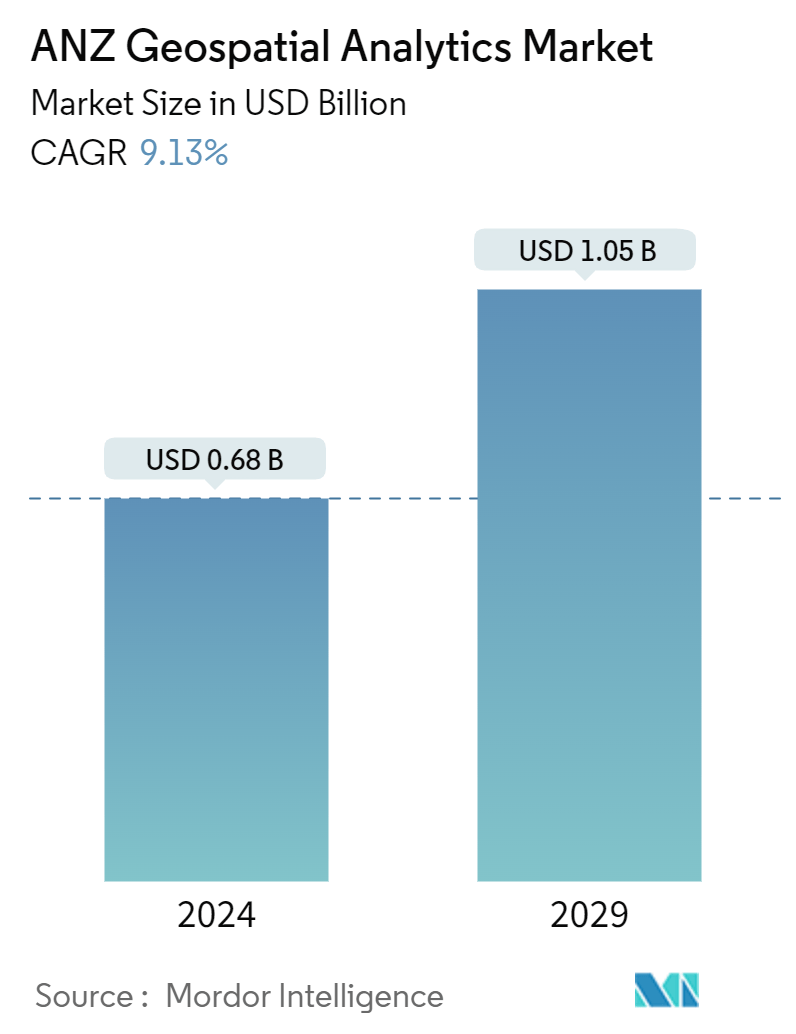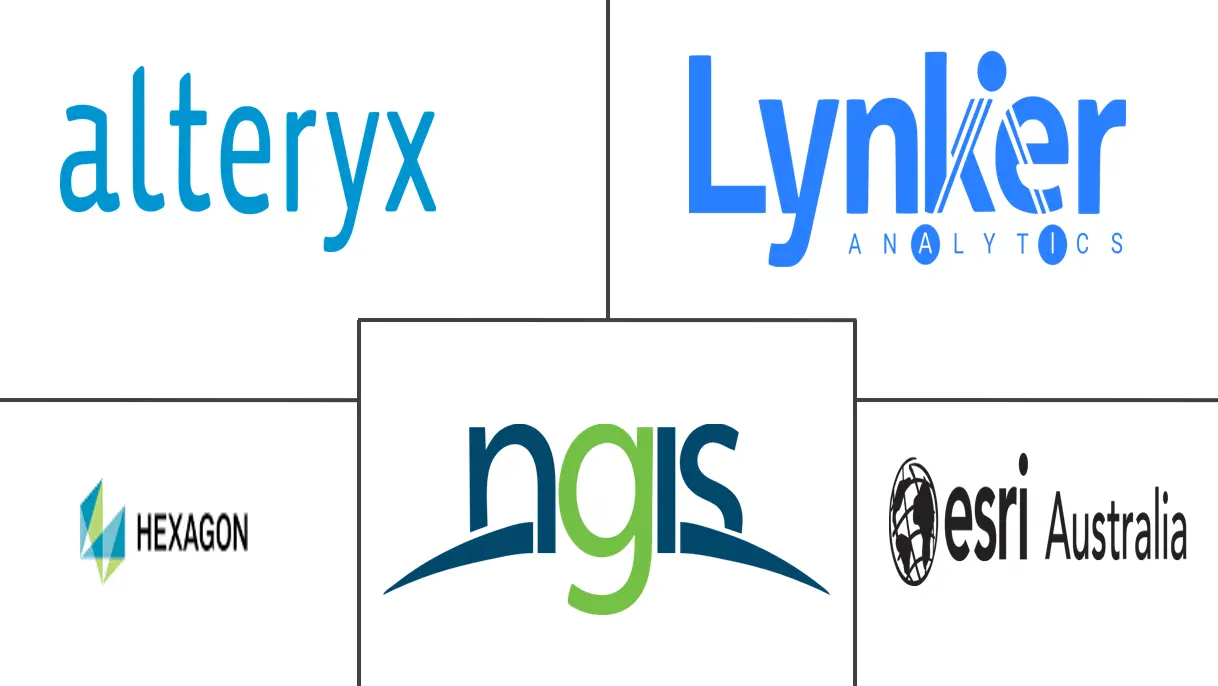Market Size of ANZ Geospatial Analytics Industry

| Study Period | 2019 - 2029 |
| Base Year For Estimation | 2023 |
| Market Size (2024) | USD 0.68 Billion |
| Market Size (2029) | USD 1.05 Billion |
| CAGR (2024 - 2029) | 9.13 % |
| Market Concentration | Medium |
Major Players
*Disclaimer: Major Players sorted in no particular order |
ANZ Geospatial Analytics Market Analysis
The ANZ Geospatial Analytics Market size is estimated at USD 0.68 billion in 2024, and is expected to reach USD 1.05 billion by 2029, growing at a CAGR of 9.13% during the forecast period (2024-2029).
The ANZ geospatial analytics market is driven by the increasing demand from various public and private end-user industries, the presence of major market players, and the increasing demand for geospatial analytics in urban planning.
- The ANZ geospatial analytics ecosystem has witnessed substantial growth in the past couple of years owing to the growth in innovative geospatial analytics solutions by the market players and the increasing use of advanced technologies such as artificial intelligence(AI) and machine learning(ML) for meaningful insights from the geospatial data.
- Moreover, the increasing use of location information to make informed decisions further drives the demand for geospatial capabilities and geospatial analytics solutions in the region.
- Market vendors in the region are using advanced technologies to offer innovative analytics capabilities in the geospatial domain, which is further analyzed to boost the demand for geospatial analytics solutions in the end-user industries across the region. For instance, Australia-based geospatial intelligence has considerable expertise in geospatial analysis, big data & link analytics, machine learning, artificial intelligence, and the development of effective user interfaces.
- These skills allow the company to develop sophisticated and innovative geospatial analytical tools that automate the extraction of data and information from large data sets and display this information in a format that supports informed decision-making.
- The increasing availability and accessibility of geospatial data from satellites, sensors, etc., aided the market's growth, as the geospatial data can provide substantial informed decisions and valuable insights by leveraging geospatial analytics solutions in organizations across the region. For instance, the National mapping agency Land Information New Zealand (LINZ) focused on publishing detailed geospatial data that models New Zealand's built and natural environments. LINZ shares its datasets-from road and river data to aerial imagery and LiDAR-on data.linz.govt.nz.
- Further, in May 2023, Vexcel Data Program announced free access to aerial imagery in New Zealand and Australia through its web-based platform, Viewer. This no-cost access provides commercial and government users with high-resolution, highly accurate imagery of major metro areas such as Perth, Auckland, Sydney, Melbourne, Brisbane, Wellington, and Christchurch. Australian and New Zealand organizations are eligible to participate in this free offering.
- Such factors are further expected to offer growth opportunities for the geospatial analytics market in the region over the forecast period. Such factors have driven organizations' demand for geospatial analytics solutions to maximize benefits and competitive edge from the spatial data from imagery, satellites, and sensors.
ANZ Geospatial Analytics Industry Segmentation
Geospatial analytics is the process of acquiring, manipulating, and displaying imagery and data from the geographic information system (GIS), such as satellite photos and global positioning system (GPS) data. The specific identifiers of a street address and a zip code are used in geospatial data analytics. They are used to create geographic models and data visualizations for more accurate trends modeling and forecasting.
The ANZ geospatial analytics market is segmented by type (surface analysis, network analysis, and geovisualization), by end-user vertical ( agriculture, utility and communication, defense and intelligence, government, mining and natural resources, automotive and transportation, healthcare, real estate and construction, and other end-user verticals), and by country (Australia and New Zealand). The market sizes and forecasts are provided in terms of value USD for all the above segments.
| By Type | |
| Surface Analysis | |
| Network Analysis | |
| Geovisualization |
| By End-user Vertical | |
| Agriculture | |
| Utility and Communication | |
| Defense and Intelligence | |
| Government | |
| Mining and Natural Resources | |
| Automotive and Transportation | |
| Healthcare | |
| Real Estate and Construction | |
| Other End-user Verticals |
| By Country | |
| Australia | |
| New Zealand |
ANZ Geospatial Analytics Market Size Summary
The ANZ geospatial analytics market is experiencing significant growth, driven by increasing demand from both public and private sectors, the presence of major market players, and the rising need for geospatial analytics in urban planning. The market is benefiting from the integration of advanced technologies such as artificial intelligence and machine learning, which are being used to derive meaningful insights from geospatial data. The availability of geospatial data from satellites and sensors is further propelling market expansion, as organizations leverage these insights for informed decision-making. Companies in the region, such as Australia-based geospatial intelligence firms, are developing innovative tools that automate data extraction and enhance decision-making processes. The agriculture sector, in particular, is witnessing substantial adoption of geospatial analytics solutions, with precision agriculture practices driving demand for advanced analytics to optimize resource use and improve farm management.
Australia is poised for substantial growth in geospatial analytics adoption across various industries, including agriculture and urban planning. The country's high degree of urbanization and population growth is increasing the demand for effective urban planning solutions. Prominent market vendors in Australia are continuously innovating their offerings, providing solutions that enhance site selection, profitability analysis, and competitive understanding for sectors like retail. Utility companies are also leveraging geospatial analytics to optimize network performance and implement predictive maintenance strategies. The market is moderately consolidated, with key players engaging in partnerships and acquisitions to enhance their service offerings. Notable collaborations, such as those between Geospatial Intelligence Pty Ltd and Satellogic, as well as Ecopia AI and Woolpert, are contributing to the development of high-resolution geospatial data solutions, further supporting market growth in the region.
ANZ Geospatial Analytics Market Market Size - Table of Contents
-
1. MARKET INSIGHTS
-
1.1 Market Overview
-
1.2 Industry Attractiveness - Porter's Five Forces Analysis
-
1.2.1 Bargaining Power of Buyers
-
1.2.2 Bargaining Power of Suppliers
-
1.2.3 Threat of New Entrants
-
1.2.4 Threat of Substitutes
-
1.2.5 Intensity of Competitive Rivalry
-
-
1.3 Industry Value Chain Analysis
-
1.4 Assessment of the Impact of COVID-19 on the Market
-
-
2. MARKET SEGMENTATION
-
2.1 By Type
-
2.1.1 Surface Analysis
-
2.1.2 Network Analysis
-
2.1.3 Geovisualization
-
-
2.2 By End-user Vertical
-
2.2.1 Agriculture
-
2.2.2 Utility and Communication
-
2.2.3 Defense and Intelligence
-
2.2.4 Government
-
2.2.5 Mining and Natural Resources
-
2.2.6 Automotive and Transportation
-
2.2.7 Healthcare
-
2.2.8 Real Estate and Construction
-
2.2.9 Other End-user Verticals
-
-
2.3 By Country
-
2.3.1 Australia
-
2.3.2 New Zealand
-
-
ANZ Geospatial Analytics Market Market Size FAQs
How big is the ANZ Geospatial Analytics Market?
The ANZ Geospatial Analytics Market size is expected to reach USD 0.68 billion in 2024 and grow at a CAGR of 9.13% to reach USD 1.05 billion by 2029.
What is the current ANZ Geospatial Analytics Market size?
In 2024, the ANZ Geospatial Analytics Market size is expected to reach USD 0.68 billion.

